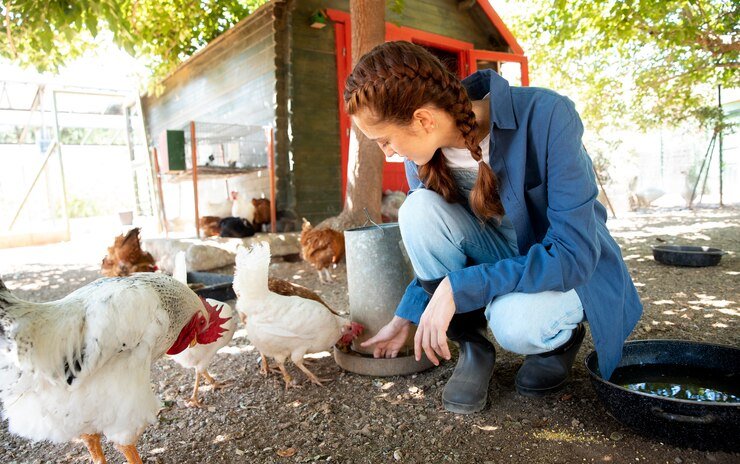Using an H-Style Cat Harness on a Chicken? Here’s What You Should Know

Pet owners are constantly finding creative solutions to enhance the safety and wellbeing of their animals. One trend that’s been catching our eye is the use of an H-style cat harness on chickens. Yes, you read that right—cat harnesses on chickens! Whether you’re a cat lover, a proud chicken owner, or somewhere in between, this guide will help you understand why this works, how to do it safely, and why it’s a growing interest among pet enthusiasts.
From understanding the benefits of an H-style harness to practical advice on customizing it for chickens, this blog has you covered.
What Is an H-Style Harness?
Before we dive into chickens, let’s first break down what an H-style harness is.
An H-style harness is a common type of harness for cats (and sometimes small dogs), made with adjustable straps that form an “H” shape when laid flat. This simple yet effective design is popular for its comfort and safety. Unlike traditional collars, which can press dangerously against a cat’s neck, an H-style harness distributes weight evenly across their chest and shoulders. This provides better control during walks or outdoor adventures.
Benefits of Using a Harness Over a Collar
- Improved Safety: Collars create health risks when a pet pulls away unexpectedly. Harnesses lessen that pressure on their neck.
- Comfortable Fit: Since the harness wraps around the chest and back, it applies minimal pressure, making outdoor activities more enjoyable for pets.
- Versatile Use: H-style harnesses are lightweight, easy to use, and ideal for smaller animals, which is exactly why they’re now gaining interest in the chicken-owning community!
Customizing for Chickens? Here’s How to Adapt It
Here’s where things get fun. Believe it or not, many people have found that the H-style harness isn’t just suitable for cats—it works surprisingly well for chickens too! But, chickens have very different anatomy than cats, which means the harness needs some adjusting.
Size Adjustments
Chickens are shaped differently from cats, with slender necks and broader bodies. To ensure the harness fits comfortably:
- Opt for a small or extra-small cat harness.
- Ensure the straps are adjustable to fit snugly around the chicken’s wings and torso without restricting movement.
Material Considerations
A high-quality, soft material is essential—most chickens are not accustomed to wearing any kind of accessory. Nylon is a common option, as it’s durable yet gentle on their feathers.
Safety Features
Choose a harness with a secure buckle or snap closure. Avoid harnesses with excessive hardware, as this can get caught on items in the chicken’s environment. Reflective straps may also be useful for outdoor visibility.
Why Are Chickens Becoming Such Popular Pets?
Urban and suburban areas are seeing an unexpected rise in pet chickens—a trend fueled by the desire for sustainable food sources and unique companionship. Unlike cats or dogs, chickens provide eggs, have quirky personalities, and serve as lovable (and often hilarious) backyard pets.
How Do Cats and Chickens Get Along?
Interestingly, many cat lovers are chicken enthusiasts as well. While cats may have a natural predatory instinct around birds, introductions can often result in peaceful coexistence with proper training and precautions. Using a harness helps create controlled interactions between cats and chickens, ensuring safety for both animals.
Safety First! How to Introduce the Harness
Whether you’re fitting the H-style harness to a cat or customizing it for a chicken, patience is critical. Here’s a step-by-step guide to ensuring a safe and stress-free introduction:
- Introduce the Harness Gradually: Start by letting your pet sniff and explore the harness. Allow them to get accustomed to it before trying it on.
- Fit Properly: For chickens, place the harness carefully around their wings and midsection, ensuring it’s snug but not too tight. For cats, ensure the harness fits securely around their chest.
- Short Sessions: Keep the first wearing session brief—just a few minutes. Gradually increase the duration as your cat or chicken grows more comfortable.
- Use Positive Reinforcement: Offer treats and verbal praise during the process to create a positive experience.
- Monitor Interactions: If you plan to use the harness for interactions between cats and chickens, always supervise. Cats may interpret the harness as an impediment to natural movement, so make introductions in a controlled space.
Real-Life Success Stories
Wondering if this actually works? Meet some pet owners who’ve turned harness experiments into harmony:
- Sara’s Story (San Diego, CA): “I started using an H-style harness on my chicken, Brownie, when I noticed how much she wandered in our suburban backyard. Now I have better control, and our cat Whiskers has stopped chasing her!”
- Jasmine’s Journey (Austin, TX): “Our rescue cat Oliver was scared of our chickens. Adding a harness helped me build his confidence because I could guide him while keeping everyone safe.”
- Mike’s Marvelous Chickens (Nashville, TN): “The harness allows me to train my chickens for local pet parades. They love it, and so do the spectators.”
Have your own story? We’d love to hear it—share it in the comments below!
Transform the Way You Care for Your Pets
H-style cat harnesses on chickens may sound unconventional, but they’re a surprisingly effective tool for pet owners looking to manage multi-species households. By customizing the harness for your feathered friends, you can create safer and more controlled environments, whether at home or outdoors.
Whether you’re a cat lover trying to manage new backyard pets or a chicken enthusiast looking for better control, harnesses offer solutions that bring pets and their humans closer together. Have fun experimenting, and feel free to share your experiences with the pet-loving community!
